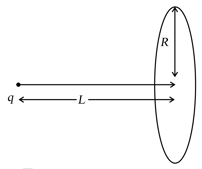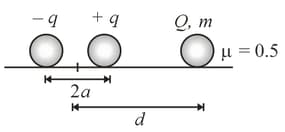The electric flux through ring shown in figure is



Important Questions on Electric Charges and Fields
The electric field at distance will be
Charge is uniformly distributed with volume charge density in a spherical volume of radius A cavity of radius is made in the charge distribution such that the centre of the cavity is at position vector from the centre of the charge distribution, then the electric field in the cavity is

A dipole having charges and is fixed on a rough surface as shown. Another charge of mass is placed at distance from this dipole. The minimum value of for which charge will not move. (Given , co-efficient of static friction )

Two balls of charges and initially have exactly same velocity. Both the balls are, subjected to same uniform electric field for same time. As a result, the velocity of the first ball is reduced to half of its initial value and its direction changes by The direction of the velocity of second ball is found to change by
The electric field and initial velocity of the charged particle are inclined at angle
Two balls of charges and initially have exactly same velocity. Both the balls are, subjected to same uniform electric field for same time. As a result, the velocity of the first ball is reduced to half of its initial value and its direction changes by The direction of the velocity of second ball is found to change by
If new velocity of second charged particle has a magnitude times the initial velocity, then is
